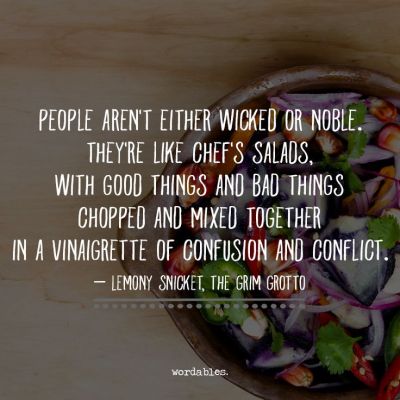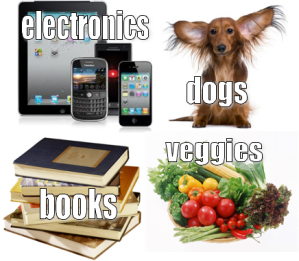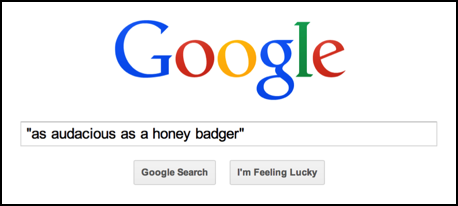Astound your teachers by becoming a metaphor master! Impress your friends with your command of the literal and figurative! In this lesson you’ll get the quick and dirty, just-the-facts-ma’am introduction to what figurative language is, and how and when to use it. You’ll meet metaphors and similes, find examples in everything from sonnets to Selena Gomez, and then create a few original ones yourself. Once you know these concepts inside and out, learn to recognize them, and even come up with your own, you’ll boost your reading comprehension, your vocabulary, AND your writing skills.
If you’ve ever read a book, listened to the radio, or had basically any kind of human interaction, then you’ve already had a lot of experience with figurative language.
If you were raised by wolves in the forgotten wilds of Ontario, you’ve never heard anything like it–get ready to have your mind blown.
You see, figurative language is so common that most of us use it all the time without even realizing. Assuming you’ve spent your life communicating with people and not howling at the moon, you probably have a whole store of figures of speech in your vocabulary.
If your dad says that a coworker stabbed him in the back, you don’t flip him over and start applying a tourniquet. Your sister’s claim that she has butterflies in her stomach doesn’t send you searching the web for a good gastroenterologist. When a friend says he’s been shot by Cupid’s arrow, you don’t dive for cover and start scanning the bushes for a baby with a crossbow.
You know that these are just expressions, that the person who speaks them doesn’t mean them literally. And that’s all figurative language is: using words in a way that implies something beyond their literal meaning.
Metaphor
There are A LOT of different ways to use figurative language, but one of the most common forms is metaphor.

A metaphor is usually defined as a comparison between 2 unlike things.
Say what?
Why would you compare unlike things? Don’t we compare things to show that they’re similar?
Yes and no. If you’re going to compare 2 things at all, they have to have something in common. But if you say, “A labradoodle is like a chihuahua: they’re both dogs,” or “a one dollar coin is like a one dollar bill; they’re both worth a dollar,” you’re not telling me anything I don’t already know.
You also won’t be winning any prizes for creativity.
Metaphors work because they make a comparison that is unexpected, so it helps us to recognize a similarity that we didn’t see before.
Let’s look at some examples. Watch the clip below find as many metaphors as you can. How many make comparisons that you have never heard before, or never would have thought of? What do these comparisons help you understand?
You probably noticed that some metaphors make explicit comparisons, saying something is something else (everyday is a winding road, you’re my kryptonite). Other times, the metaphor stands on its own, and the comparison is only implied. When Selena Gomez says, “Let this drought come to an end,” we know without her having to tell us that “the drought” she’s talking about isn’t an actual spell of dry weather–it’s a metaphor for her love life.
It’s pretty obvious from the get go that these comparisons aren’t meant literally, but figuratively. Otherwise, Ke$ha would need a bomb shelter to shield her from speaker shrapnel and Adam Levine would be asking for a cardiothoracic surgeon and a lot of morphine. In fact, if we think about them literally, the comparisons don’t make much sense; a heart and a stereo are about as unlike each other as you can get.
But that unlikely comparison just makes us even more aware of the one thing a heart and a stereo do have in common: they both have a beat.
If your boyfriend or girlfriend said to you, “Hey, you’re an alien,” he or she might be single again in a heartbeat. It doesn’t sound like the most flattering description. But Katy Perry uses this surprising expression to say that her love is unlike anything she’s ever experienced, beyond anything in this world–it’s extraterrestrial.
Unexpected, unlikely pairings grab our attention and stick in our minds. This is why figurative language is used so frequently by writers, who want their readers to sit up and take notice.
There’s a wordsmith well-known for weaving metaphors into rhymes. No, I’m not talking about Weezy, but Emily Dickinson. In 1891, she wrote a little poem comparing hope to a bird to show how hope means never giving up, and always looking on the bright side:
“Hope” is the thing with feathers—
That perches in the soul—
And sings the tune without the words—
And never stops—at all—
The great thing about metaphors is that they can take an idea that’s vague and abstract (like hope, love, life, etc.) and embody it in something concrete that we can picture in our minds. They’re a way for writers to get our imaginations going, and help us to understand something that’s difficult to get a handle on by relating it to something familiar.
Let’s try putting these ideas into practice with some metaphor mad libs. How would you complete the following phrases with names of objects, people, or images, to make an unlikely comparison.
Life is a _______________
highway? box of chocolates? Nah, we’ve heard all that before! Try to be as creative as you can.
Love is ________________
Mistakes are ____________
School is a _______________
Friends are _____________
Family is a _______________
Politicians are ________________
When I’m stressed, I am a ________________
Simile
As you can see, metaphors are often created by saying something is something else. But if you’re talking to someone who was, say, raised by wolves, and you want to make really sure they don’t take you literally, you might want to be explicit that you’re just making a comparison.
Enter the simile. Like a metaphor, a simile makes a comparison between 2 unlike things. But a simile likes to broadcast the fact that it’s only speaking figuratively. Instead of saying something is something else, a simile says something is like something else. More precisely, a simile makes its comparison by using the words “like” or “as”, as in “crazy like a fox” or “busy as a bee.”

You might describe your math teacher barking orders and growling over grades like a Doberman. Maybe you’d say your older brother starts strutting like Derek Zoolander when he sees a girl watching. (Side benefit of similes: in addition to making your English teachers happy, they’re very effective for putting snarky siblings in their place.)
Let’s check out some more examples.
See how similes use embodiment to create a vivid picture in our minds? If I said, “Did you ever feel sad?”, that would be really vague. Sure, we’ve all felt sad. But expressing it that way doesn’t conjure up any emotion; it doesn’t remind us what it’s like to feel sad. When Katy Perry says, “Did you ever feel like a plastic bag drifting through the wind?” that’s something we can all picture, and imagining it gives us exactly the sense of the kind of lost, lonely, wistful sadness she’s talking about. With that one image, she’s able to express a feeling that would have taken a whole paragraph to describe. The simile doesn’t just communicate an idea, it evokes an image and a mood.
Consider the similes in the video and think about how they conjure up a particular mood, feeling, atmosphere, or image to communicate a complicated idea in a simple way.
When Selena Gomez says, “A day without you is like a year without rain,” what does she mean? What does a drought do to a desert? So what is she saying it would do to her to go a day without the one she loves?
How about these other ones? See if you can put the meaning behind these similes into words.
When Ke$ha says she wakes up “feeling like P. Diddy”, she means…
When Taylor Swift talks about “words like knives and swords”, she’s saying that…
And when Selena Gomez says, “I love you like a love song,” she means…
Do you notice that you generally need a lot more words to explain the simile, while the image itself manages to communicate in a much more streamlined, efficient way. That’s because similes and metaphors use things that we are already familiar with to make their comparisons, so that they can communicate a whole set of meanings and associations with one simple image. Selena Gomez doesn’t have to list for you the emotions that a love song usually includes: we’ve all heard a hundred or more, we know the drill. Figurative language is so effective because it relates new ideas to things we already know and understand.
Check out this quote from Lemony Snicket’s The Grim Grotto.
Not only does Snicket give us a picture in our minds, he conjures up an experience that we’ve probably all had: trying to pick out little bits of black olive, or green pepper, or your-distasteful-salad-ingredient-of-choice, but finding it darned difficult to separate the good from the bad.
Though sometimes doing the exact opposite can be just as effective. Consider this other Snicket gem:
“Today was a very cold and bitter day, as cold and bitter as a cup of hot chocolate, if the cup of hot chocolate had vinegar added to it and were placed in a refrigerator for several hours.”
Snicket gives us something concrete to imagine, alright, but he also makes us snicker by deliberating turning the familiar on its head, comparing something to the opposite of its opposite! (If you want to be a real smarty-pants, this kind of comparison is sometimes called a dissimile, though it’s technically got the same structure as a simile.)
So, are you ready to see if you can put what you’ve learned into practice? Flex your creative muscles and start coming up with your own examples of figurative language:
Take a look at these photos:
- First: Choose one of the people pictured above and come up with one simile and one metaphor to describe him or her. You can make your comparisons on the basis what the person looks like, but you could also describe mannerisms, personality, or habits (feel free to make them up!).
You might say, “His eyes are round blue marbles that glisten like glass,” or “Her skin looked like a newspaper abandoned on the train, faded and rumpled by the end of the day from so much use.”
- Then: Really think outside the box this time. See if you can come up with one more of each (simile and metaphor) by comparing something about your person to the objects pictured below.
You could say, “My older sister is long and slender, like an asparagus.” But try to really push the limits here. Let’s say your sister is a little over-emotional after a fight with her boyfriend: then you might say, “My sister is like an asparagus: leave her stewing too long and she’ll turn to mush and fall apart.”
Creativity check! Just for fun, let’s see what original comparisons you were able to come up with. Try copying each of the similes you came up with, and pasting them into a Google search field, with quotation marks around them, like this:
(Using quotation marks will search for the entire phrase, not just the individual words.) When you search them, you can see whether others have come up with the same simile, or if you’re the first one!
If you came up with a totally original example of figurative language, way to go! But if someone else had the same idea, that’s not necessarily a bad thing. Figurative language is a balancing act between creativity and communication. You want to avoid clichés, but if you come up with something that’s too off-the-wall, no one will understand the comparison you’re trying to make. Go for images that are both fresh and familiar, vivid but not vague.
Congrats! You’re now a Master Metaphorizer.
Someone give this individual a pat on the back and a cookie.








